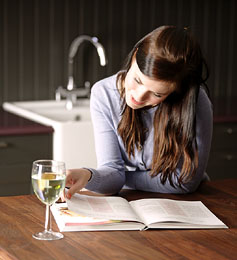 If you’re new to home winemaking, some of the language used in the wine making books and wine recipes can be very intimidating. But after you’ve done some research and have been practicing for a little while, you’ll wonder why you were ever confused to begin with!
If you’re new to home winemaking, some of the language used in the wine making books and wine recipes can be very intimidating. But after you’ve done some research and have been practicing for a little while, you’ll wonder why you were ever confused to begin with!
There are many terms to learn in home winemaking, and this post will give you a brief introduction into just a few of those terms to help you get started in home winemaking, or perhaps brush up on some of the terms you may not have seen in a while.
- Acidity: You can measure acidity in grapes, must, or wine, and is an important thing to measure throughout the home winemaking process. If you don’t have enough acid in the must, you’ll have a hard time with fermentation, and the finished wine will have a sort of medicinal flavor. You can use an acid testing kit to determine the acidity level in the must or wine, and if it looks like these levels are too low, you can add tartaric acid, malic acid, or citrus acid in order to achieve the proper acidity level for good fermentation and desirable aromas and flavors.
- Bentonite: Bentonite is a fine clay substance that is used either as a clarifying or stabilizing agent in wine. Basically, it functions to remove excess proteins in the wine, including yeast, as well as removing other fining agents or helping to achieve heat stabilization.
- Stabilization: A wine is considered to be stable or have been stabilized when the fermentation is complete. Stabilization can occur naturally, or through additives like Wine Stabilizer.
- Inoculation: To inoculate a wine is just a fancy way of describing the act of adding active wine yeast to the must or wine. Additionally, you can inoculate a wine with malolactic bacteria if you’re planning on having your wine go through malolactic fermentation.
- Lees: Lees are basically dead wine yeast plus other solids that are formed during the winemaking process. In order to remove this sediment from the wine, you can perform as few or as many rounds of racking as needed. For some wines, leaving the lees in contact with the juice for a period of time may be desirable, as this contact incorporates more complex flavors and aromas into the wine than if they were immediately removed and discarded.
- Oxidation: In very basic terms, oxidation occurs as a reaction between wine and the oxygen in the air. You want some oxidation in your wine in order to help in the development and maturation process, however, too much oxygen exposure can result in a wine that is known as being “oxidized”, which possesses undesirable flavors and aromas, as well as a browning in color.
———————————————————————————————————
Ed Kraus is a 3rd generation home brewer/winemaker and has been an owner of E. C. Kraus since 1999. He has been helping individuals make better wine and beer for over 25 years.
